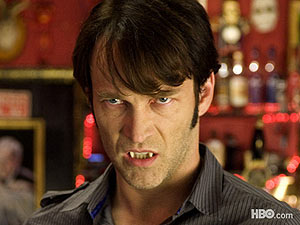Irish Things We Love: Dracula, By Bram Stoker
Published on January 30th, 2010 in: Books, Editorial, Issues, Kiss Me I'm Irish |Ask people to name some Irish things that they love, and they may come up with a list of things that are obviously Irish, like the band U2 or Guinness beer. I would argue though, that our cultural milieu, especially these days, is heavily inspired by the work of an Irish writer, specifically, Bram Stoker, author of Dracula. Both Dacre Stoker, great-grandnephew of Bram (and co-author of Dracula: the Un-Dead), and Dennis McIntyre, director of the Bram Stoker’s Dracula Organisation, advance this point of view.

Bram Stoker
Bram Stoker was an Irishman. This is easy to forget, since so much of his masterpiece takes place in England, and since he managed London’s Lyceum Theatre for almost 30 years. He was born and educated in Ireland, however, and didn’t move to London until after getting married in 1878.
For the first seven years of his life, Stoker was bed-ridden. During this time, his mother told him stories of the Cholera Epidemic of 1832, cholera being one of the diseases that gave rise to vampire legends. She also likely told him Irish legends of blood-drinking ghosts and fairies. Aspects of these stories made it into Dracula, along with other common imagery from Irish folklore. It is uncertain how much Stoker knew of the historical figure of Vlad Dracul, but the Celtic word “bad blood” is Droch Ola. (Bloodletting was probably one means used to treat young Bram.)
As he grew older, his local environment helped contribute to the dark tale he would tell. In his hometown of Clonarf, there was a suicide burial plot. One very prominent vampire legend is that suicide victims will rise again as vampires if they are not staked through the heart, buried at crossroads, or prevented in some other specific way. As a child, Bram would play there and near St. Michael’s church, where his family had its tomb and where the conditions of the air mysteriously mummified the corpses.
One of the more far-fetched theories even suggests that Dracula is actually a political allegory for the potato famine that occurred during Bram’s youth, with the bloodsucking Count as a metaphor for social injustice. Either way, Stoker’s work already has its roots soundly in the Irish tradition of storytelling
In fact, Stoker did accomplish something truly remarkable. Since its publication in 1897, Dracula has never gone out of print, and has been translated into more than 50 languages. According to the Internet Movie Database, an estimated 217 films include the character of Dracula in a major role, with as many as 649 that at least reference him. He’s also appeared on or been mentioned in countless television shows and commercials

Stephen Moyer as Bill Compton from True Blood
Photo © HBO
More than that, Stoker shaped our idea of what a vampire was. Thanks in part to dapper portrayals by the likes of Bela Lugosi and Christopher Lee, our “go-to” concept of the vampire is pale, suave, wealthy, and well-dressed. Almost every fictional vampire that has come since, from Lestat du Lioncourt to Bill Compton, owes at least a little (usually a lot) to Dracula. Seldom have their stories been more popular than they are now.
Just think about it: Every time you go shopping for a Halloween costume, and see a medallion on a red ribbon in the accessory aisle, you’re looking at part of the Dracula legacy. The same thing when you buy Count Chocula at the grocery store. That’s how ubiquitous Stoker’s vision is. Just consider how often the title “Count” and the suffix “-ula” get used, sometimes together, as shorthand for “vampire,” “scary,” “draining,” “dead,” and so on.
It’s true that Stoker was inspired by other vampire tales written shortly before his. It is also true that every culture in the world has vampire legends of some sort. Bram Stoker’s Dracula, however, is the one that has stood the test of time and become a cultural touchstone. That makes it an Irish thing that the whole world loves.
Lisa Anderson, Staff Writer
For more Irish Things We Love, check out this issue’s special feature, Kiss Me I’m Irish.
Sources:
1. “Bram Stoker’s Dracula – more Irish than Transylvanian?” Thatsweird.net.
2. “Dracula,” Wikipedia
3. Lisa Anderson, “The Rebirth Of The Un-Dead: Q&A With Dacre Stoker,” Popshifter, January 30, 2010.
One Response to “Irish Things We Love: Dracula, By Bram Stoker”
February 4th, 2010 at 10:18 am
This is fascinating! I try to read Dracula once every couple of years. It’s definitely one of my faves.
LLM
Time limit is exhausted. Please reload the CAPTCHA.